Workstation Cranes & Rail Systems
Knight’s Rail Systems are designed to provide a safe and efficient solution to your ergonomic challenges. We offer a wide range of options to meet all your specific engineering and application requirements.
Our Lightweight Aluminum Rail Series eases installation and reduces overhead rail load requirements. It is manufactured from high strength alloy, making it an ideal solution for whether your load is located directly under the system or cantilevered off to the side. We offer 13 different series of aluminum rail that are available in multiple shapes and configurations.
Knight’s Suspension Rail System includes an enclosed trolley track that resists dirt build-up for a smoother and quieter operation. Floor Mounted Rail Suspension System is available in single or dual bridge configurations.
General Information
+Features
- Mechanical Properties: ASTM B221 6005-T5 Series Aluminum.
- Multiple Overhead and Floor Mounted Configurations.
- Supports Trolleys, End Trucks and Hangers.
- Transfer Loads in the “X” and “Y” Directions.
- Max. Capacity: Up to 3,000 lbs. [1,360kg].
Benefits
- Pre-Assembled Accessories
- Accessories can be positioned along the rail; no welding required.
Selecting your Workstation Crane System
+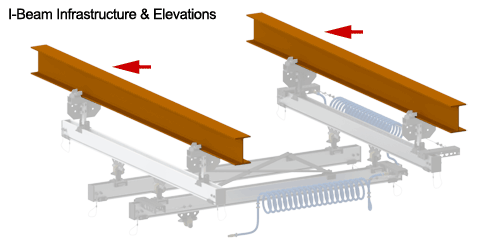
Step 1: Know Your Infrastructure and Elevations
The first step is to know what types of structural supports are within the working area. If there is not any structural supports to suspend a rail system from, Knight Global also offers Floor Mounted Rail Suspension Systems. It is also important to know the elevation of the structural supports and working heights of the application.
Contact your local Knight representative today for assistance.

Step 2: Select Your Structural Hangers
Knight structural hangers are designed to work in conjunction with I-Beams and C-Channel structural supports. Hangers are designed to fit flanges ranging from 2 in. to 11 in. They ensure that structures are within a level environment. If not, then it may be necessary to use adjustable height hangers to compensate for unevenness.
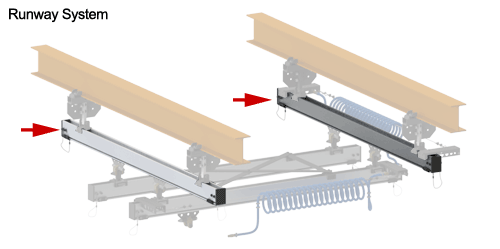
Step 3: Select Your Runway System
Decide which size and length or rail that is needed to build the runways. Aluminum rail comes in 4 in., 6 in. or 8 in. configurations. A simple monorail system for inline point to point transfer of loads can be used with just a runway.
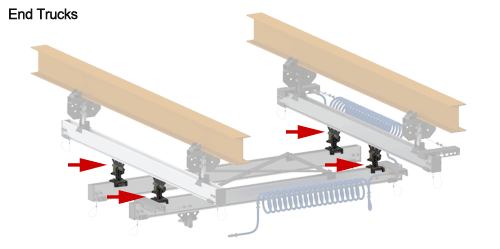
Step 4: Select Your End Trucks
Knight End Trucks are a combination of a trolley and a rail structural hanger that joins the bridge to the runway. End trucks are designed to interact with different rail sizes. The end truck trolley must match the configuration of the runway, and the end truck hanger must match the configuration of the bridge.
End trucks are available in many different configurations such as: Single Bridge, Dual Bridge (shown), Dual Trolley, Same Plane, and Rigid.
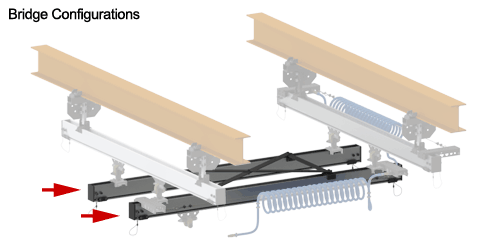
Step 5: Select Your Bridge Configurations
A runway/ bridge configuration provides for total freedom of movement in the “X”, “Y” or horizontal planes providing access to the entire work area. Bridge rail selection is similar to runway rail selection with one additional criteria – is the load offset (cantilevered) or direct?
For direct load applications, typically balancer applications, a single bridge is used. For offset load applications, a dual bridge is used.
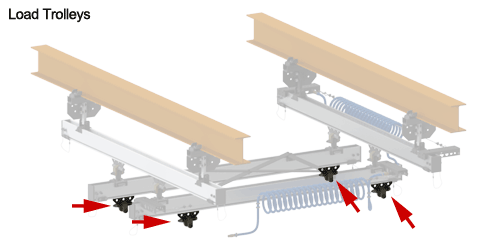
Step 6: Select Your Load Trolleys
A load trolley must match the configuration of the bridge. Load trolleys are available in many different configurations such as: Boss Trolley, Yoke Trolley (shown), Eye-Hook Trolley, Balancer Trolley, and Servo Hoist Trolleys.
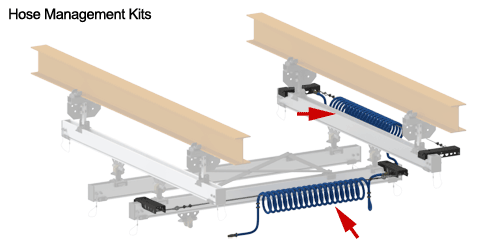
Step 7: Select a Hose Management Solution
Knight Global Hose Management are available for both runway/ monorail and bridge cranes. These kits include: brackets, fittings, messenger cables, whip hoses, and tensioners required to supply air to the rail system.
Regulators and hoses (festooned or coiled) are ordered separately.
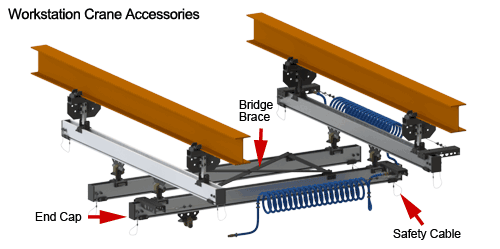
Step 8: Select Your Workstation Crane and Rail Accessories
Knight Global provides multiple accessories for Workstation Crane System and Rails. These include: Redundant End Caps (Illustration A), Bridge Braces, Mid-Rail Stops, Air or Electric Tractors, Weld-Free Splice Kits, Access Gates (Illustration B) and Safety Cables.
